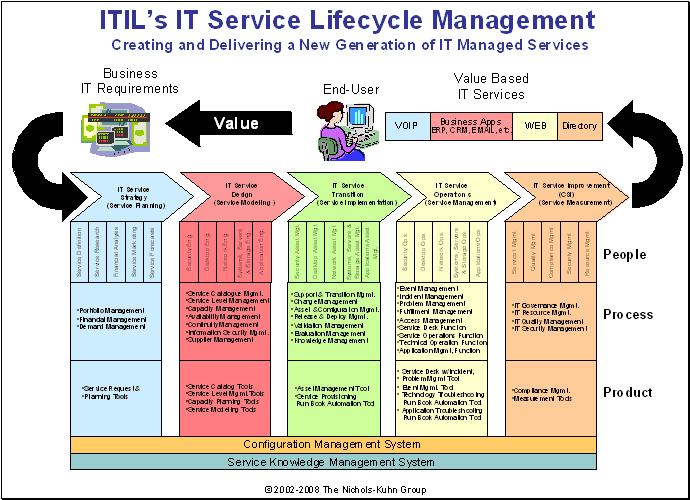Successful ITIL adoption depends upon cross-silo process interaction and shared responsibilities. ITIL Version 3 carves IT into five domains (Strategy, Design, Transition, Operation and Improvement) and outlines for each the people, process and product requirements to build a structure for the domain within the IT organization.
The following newsletter provides a high-level blueprint of how IT organizations can align themselves and their service delivery partners with the five domains of ITIL V3. This alignment will enable IT to create and deliver a new generation of managed IT services optimized for cost, quality and compliance with security and government mandates.
While ITIL V2 served its purpose of making IT organizations aware that IT service management could be done better, ITIL V3 provides the detail on how to make them better. By carving IT up into ‘silos of purpose’ of Strategy, Design, Transition, Operation and Improvement, ITIL V3 provides guidance on how to:
- Align service delivery team members (internal and external) with the domain silo they are responsible for within their respective departmental silos.
- Build out the process areas to ensure that team members are operating within the ITIL guidelines specified for each domain.
- Select and implement products and or services that will automate any or all aspects of the domain workflow and task requirements.
ITIL’s IT Service Lifecycle Management Model
The figure below represents the five domains of ITIL’s IT Service Lifecycle along with the people, process and products required to make each domain fulfill its ‘silo of purpose’ within the IT organization.

IT Service Strategy – Planning the IT Services
Service Strategy deals with the strategic analysis, planning, positioning, and implementation relating to IT service models, strategies, and objectives. It provides guidance on leveraging service management capabilities to effectively deliver value to customers and illustrate value for service providers.
The following people, process and products combine to make this a functional operating unit with IT:
- People
- Service Definition Manager
- Service Research Manager
- Financial Analysis Manager
- Service Marketing Manager
- Service Forecast Manager
- Process
- Portfolio Management
- Financial Management
- Demand Management
- Products
- Service Request & Planning Tools
- Service Knowledge & Configuration Management Tools
IT Service Design –Modeling the IT Services
Service Design translates strategic plans and objectives and creates the designs and specifications for execution through service transition and operations.
- People
- Security Engineering Manager
- Desktop Engineering Manager
- Network Engineering Manager
- Systems, Servers & Storage Engineering Manager
- Applications Engineering Manager
- Process
- Service Catalogue Management
- Service Level Management
- Capacity Management
- Availability Management
- Continuity Management
- Information Security Management
- Supplier Management
- Products
- Service Catalogue Tools
- Service Level Management Tools
- Capacity Planning Tools
- Service Modeling Tools
- Service Knowledge & Configuration Management Tools
IT Service Transition - Implementing the IT Services
Service Transition provides guidance on the service design and implementation, ensuring that the service delivers the intended strategy and can be operated and maintained effectively.
- People
- Security Asset Manager
- Desktop Asset Manager
- Network Asset Manager
- Systems, Servers & Storage Asset Manager
- Applications Asset Manager
- Process
- Support & Transition Management
- Change Management
- Asset & Configuration Management
- Release & Deploy Management
- Validation Management
- Evaluation Management
- Knowledge Management
- Products
- Asset Management Tool
- Service provision Tool
- Run Book Task Automation Tools
- Service Knowledge & Configuration Management Tools
IT Service Operation – Managing the IT Services
Service Operation provides guidance on managing a service through its day-to-day production life. It also provides guidance on supporting operations by means of new models and architectures such as shared services, utility computing, web services, and mobile commerce.
- People
- Security Operation Manager
- Desktop Operations Manager
- Network Operations Manager
- Systems, Server & Storage Operations Manager
- Applications Operations Manager
- Process
- Event Management
- Incident Management
- Problem Management
- Fulfillment Management
- Access Management
- Service Desk Function Management
- Service Operations Function Management
- Technical Operations Function Management
- Application Operations Function Management
- Products
- Service Desk with Incident Management Tool
- Problem Management Tool
- Event Management Tool
- Run Book Technology Troubleshooting Tool
- Run Book Application Troubleshooting Tool
- Service Knowledge & Configuration Management Tools
IT Continual Service Improvement – Measuring the IT Services
Continual Service Improvement provides guidance on measuring service performance through the service life-cycle, suggesting improvements in service quality, operational efficiency and business continuity.
- People
- Service Measurement Manager
- Quality Measurement Manager
- Compliance Measurement Manager
- Security Measurement Manager
- Resource Measurement Manager
- Process
- IT Governance Management (using COBIT best practices)
- IT Resource Management (using PMI methods)
- IT Quality Management (using Six Sigma methods)
- IT Security Management (using ISO standards)
- Products
- Compliance Management & Measurement Tools
- Service Knowledge & Configuration Management Tools
Conclusion
Utilize the five domains of IT as ‘silos of purpose’ that speed the journey toward IT operational excellence by building three capabilities into the Business/IT alignment model:
- Align service delivery team members (internal & external) with each ITIL V3 domain, in addition to their respective departmental and technological functions.
- Build out both the ITIL process and the ITIL domain areas for each functional unit.
- Select and implement the products that will automate any or all aspects of each functional unit and ITIL domain workflow and task requirements.